Dr. Deborah Kelley: Video Transcript
Hear Dr. Kelley talk about her job, some of the tools she uses to conduct research, and about the 2005 Lost City Exploration. Download (mp4, 111 MB).
Introduction
My name is Debbie Kelley, I work at the University of Washington and I'm an Associate Professor in Marine Geology. So my job is basically three different components. The first, which is my favorite, is going to sea on research expeditions using robotic vehicles and submersibles to look at the sea floor and understand what happens down there. The second part is actually collecting the data, bring it back, working it up in the laboratory. Then the third part, which I also very much enjoy, is interacting with the graduate students who are also working on the samples that we bring back.
I started out my undergraduate career mostly looking at hard rock geology and what I mean by that is looking mostly at rocks on land… volcanic systems on land. And then early on I took an oceanography class and just feel in love with the oceans. I got to go to sea at a pretty early age during my undergraduate career and recognized there couldn't be any better place, hardly. It sort of just transpired by luck. I was on a cruise that discovered one of the first hydrothermal fields; the black-smoker system. And from then on I just feel in love with the environment down there and how dynamic... and the animals that live down there.
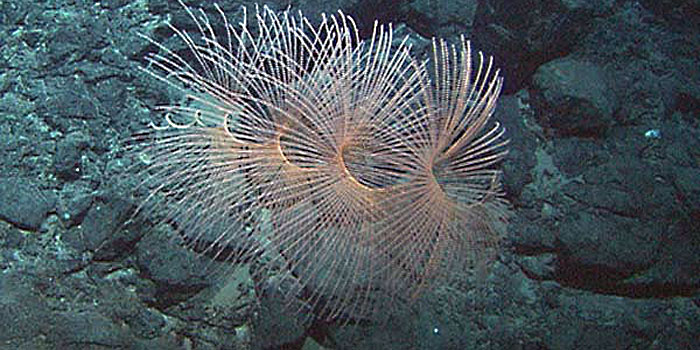
Did you know that underwater volcanoes can support life? Dr. Kelley talks about this aspect of her research.
Working at Sea
Most of my research focuses right now on, really, the interactions of volcanoes and how volcanoes support life on this planet in submarine environments; so at water depths of maybe 2,000 meters or greater. We know that the volcanoes put out volcanic gases in that the micro-organisms that live around the volcano and some of the hot springs thrive on those volcanic gases. It's estimated that we know less than 1% of the kinds of microbes that live in this environment. And yet it might rival... If you took all the biomass that's living... All the microbial communities living in the seafloor. It actually might rival that on the surface of the planet... on the continents. So it's a big unknown right now and one of the things I think in the next decade we'll be exploring.
My responsibilities at sea vary. Often I sail as two scientist or coaching scientist. For me it's a gift. I very much enjoy it. I get to work with a lot of really amazing people and it really forms a long-time friendship with many of the people. So much of my responsibility is basically making sure that everybody on the cruise gets what they need to get their science done. Looking out for them, organizing the dives, and really just planning and a lot of interaction with the science party.
Some of the main challenges in working at sea... One is the weather. You have plans that maybe have been laid out for 3 or 4 years prior to going out there. Usually within a couple of days those plans get changed quite dramatically due to weather or equipment failures. Other challenges are that the ships are relatively small, maybe 300 feet long or so and there's a science party of maybe 30-something people. Integrated the science party and making sure the people get what they need for their research is... can be challenging at times.
One of the most things I like about going to sea is just being out on the water and probably my favorite part is the opportunities for discovery. Almost every cruise I've been on we found new things we didn't know about and to me that's... You don't get... There’re not many people that can do that in their lifetime so it's something I always look forward to.
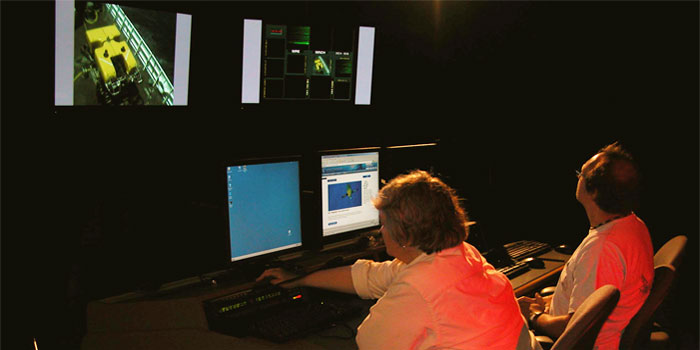
Dr. Kelley talks about what it was like to conduct science remotely by telepresence.
Telepresence
For this expedition out to Lost City, we tried a really different model for going to sea and that is by conducting science remotely by telepresence. So the entire science party, or pretty much the entire science party came to the University of Washington and we worked together for 10 days and communicated with the ship via satellite. So there were a lot of new things to learn in terms of how to communicate from land to sea over 4,500 miles away.
My role in this expedition was basically being a land-based chief scientist. So a lot of what I did helped plan the dives. Make sure that all the samples that got taken need to be taken. Lost City is a pretty complex environment so one of the major goals on this cruise was to get co registered samples of the biology of the rocks and the fluids. So we can really understand how life is intertwined with the rocks down there.
So one of the things that was very different about this expedition was having all the science party on land, in one room basically, and interacting with the ship remotely over satellite. So we... There's about 20, 24 scientist, that came for the 10 days included students, undergrads, grad students. And basically what we did is we set up a bunch of computers where we did active logging during the entire program. And everything we saw coming over the satellite; all the imagery we logged what we were seeing. What kind of animals that were... What the images were as they were streaming in.
I guess one of the fun things for me for this program was for this expedition was actually being able to do the live shows. I had never done them before and it took a little while to get used to but... I very much enjoyed the questions that came in from students all across the country and also the opportunity to interact with the ship and partake in some of their fun. There was a lot of kidding on the show and we always had a really fun time.
So I think one of the things I've learned on this expedition, working at sea remotely on land, is that similar to being at sea there's always changing conditions. It's very hard to predict how things will go on programs. So for me one of the biggest learning processes is just dealing with the daily change and working out your schedules. It's hard to get too set in your mind of things that you want to do and you have to be really flexible and compromising and I think that's a good life lesson to learn anyway. For me, the most exciting thing about this mission was really seeing a view of Lost City that we've never seen before. We'd been there on two different expedition using submersibles, but you never got the overview of the structures. The largest tower in Lost City is over 200 feet tall. What was very, very nice was to be able to see the eye in the sky view with Hercules and Argus sitting above it. We got to see images we've just never seen before. It gave us a very different impression of the field in some places.
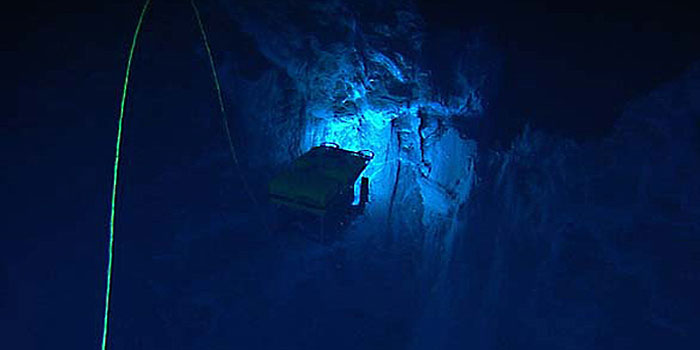
Planning for a dive remotely means overcoming a range of challenges
Remote Planning for Dives
So within the control room at the University of Washington, we had three different panels set up that were bringing in imagery from the ship. We could talk to this ship and ask them which images to bring in. And we also got to see the pre-dive and post-dive operations and so some of the things we saw during that time period were the vehicles sitting on the deck getting ready to go in. And it gave us some kind of breathing room to prepare for the next dive.
For planning out each of the dives, we'd try to get most of the science party to meet during the day. It was an interesting interaction because things evolved very rapidly so we would... there were usually at least 12 people in the room and everyone had different expertise and so one of the nice things was that we could talk about the images that we were seeing in real-time. We had geologists, biologists, fluid chemists, and so we could interact and plan out a kind of evolution of the dive. What we hoped during the dive and also how to evolve during the entire period.
So some of the things that are important in planning out the dives is number 1, knowing where you are; knowing where the vehicle is and planning out the routes the vehicles are going to ride around. On one of the main images we had coming in continuously was a map of the field, a very detailed map that was produced at meter resolution with an autonomous vehicle on the cruise. So we use those mapping images a lot and actually one of the nice things about this program was we actually had the navigation of the vehicle in real-time so from 4,500 miles away we had images coming in of the base map we were working on or the typography basically and then we would have a little symbol that showed us where both Hercules and Argus were; and the ships. So we used that a lot.
One of the challenges there is when you're working in an area where there's chimneys that are 200 feet tall and two vehicles on a tether, the last thing you want to get is the vehicles wrapped around the chimneys. So we spent a lot of time looking at the maps figuring out the best and easiest directions with interacting with the pilots and doing that.
Other data that we had coming in we had a lot of the images coming in we used those on different monitoring screens. And then we had images... a lot of data coming in about the heading of the vehicle, how high it was off the bottom which could be very useful for getting around.
For the dives we initially had planned to have very, very long dives; to have the vehicle down as long as possible; could be several days. For this program it didn't quite work out that way and we ended up having usually a dive a day. Where we'd go down, take a lot of images, we were gifted... we were very lucky to have such a remarkable video with the high definition images we got from both Hercules and Argus. A lot of time we were... what the chimneys look like provides a lot of information to us about how they form. We spent a lot of time imaging and so a lot of the discussion inside the control room was basically trying to figure out what we were looking at and then based on that where we would sample.
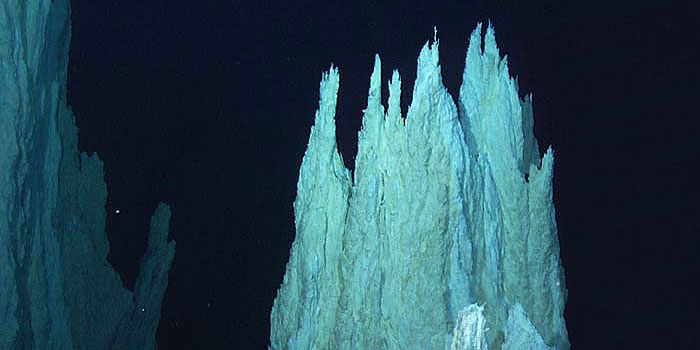
Why is the "Lost City" called the "Lost City"? And what makes it so unusual
Lost City
The reason that we call Lost City, "Lost City," is that when we discovered the field in 2000 we were on the research ship Atlantis. And also the Lost City field is sitting on a very large mountain called the Atlantis Massif. And it's bounded to the south by a very large fracture zone kind of like the San Andreas Fault. It's also called the Atlantis fracture zone. So there was the Atlantis component and also when we first dove on the chimneys, they were very, kind of, reminiscent of Greek towers and so the whole thing just kind of fit in.
One of the reasons that I'm fascinated about hydrothermal fields in general and hydrothermal vent systems is that they can tell us a lot about how life evolved on the planet and also about the amazing environments that life can figure out how to make its way in. The hydrothermal vents that we're looked at range in temperatures from just a little bit above ambient temperature actually just a little bit above freezing sea water to temperatures of over 700 degrees Fahrenheit. In some causes, as it is with black smokers, the vent fluids are acidic, very, very hot, very rich in toxic metals that would kill most of us. In contrast to Lost City where the fluids are more temperate; about 200 degrees Fahrenheit and they have properties similar to liquid drain-o. So one of the amazing things for me is to try and figure out how the organisms live there and what the relationship of the geology is to the animal populations that live in these sites.
The best systems we look at the way that they form, either a Black Smoker system or in something like Lost City is it... Basically we have a heat source. imagine heating up a pan of water on your stove and what you see as you heat that up the fluids overturn and we call those convection cells. And the same thing happens in the oceanic crust where we have a heat source. Either a magma chamber or hot rock and as the crust ages in these environments and these spreading environments large fractures form in the sea floor and the sea water migrates down along the fracture and as it gets near the hot rock it heats up and as it does that it becomes buoyant, it rises to the surface, and it entrains cold seawater down on the down welling so it's very similar to a pot of boiling water.
One of the... in contrast to Black Smokers, one of the biggest differences about Lost City is that it's actually not driven by volcanic heat. The Atlantis Mountain is made by rocks that were formed very deep in the Earth and they're very unstable now, so just the interaction of seawater generates its own heat. Because volcanoes aren't involved the fluid chemistries are fundamentally different also than Black Smokers. They're not as warm. They're about 200 degrees Fahrenheit. That's the hottest that we see. About 90 degrees C. And they are... Instead of having a lot of Carbon Dioxide, they have a lot of methane and hydrogen associated with that. Because those gases are what the microbes live on, we also see very different kinds of microbial populations in Lost City than we do in Black Smoker.
I really like these two examples. In this hand I a sample of Black Smoker that had 300 degree Celsius fluid going through it, so about 700 degrees F. And these Black Smokers, this is a very characteristic sample. It's a piece of a big pipe, basically, it's all made out of metal sulfide. Things like calcium pyrite, it's a copper-iron sulfide. Fool's gold is another mineral called pyrite. And this is very characteristic of chimneys.
In contrast, one of the reasons we knew Lost City was so different, is that you can really just tell immediately just by looking at the chimneys. They're bright white in appearance. They're very porous and they're made out of a material called calcite or aragonite which is a calcium carbonate mineral similar to Limestone, similar to the same thing you'd find in a cave.
One of the big questions about Lost City is whether it's unique and how many more of them are out there. Black Smokers were first found in about 1977, 1979. Since then we've found over 200 fields and so there's no reason to believe that we were so lucky that we found the only Lost City. And one of the big challenges now for the next several years is to go in other places, other parts of the ocean, and look to see if we can find some more of these systems.
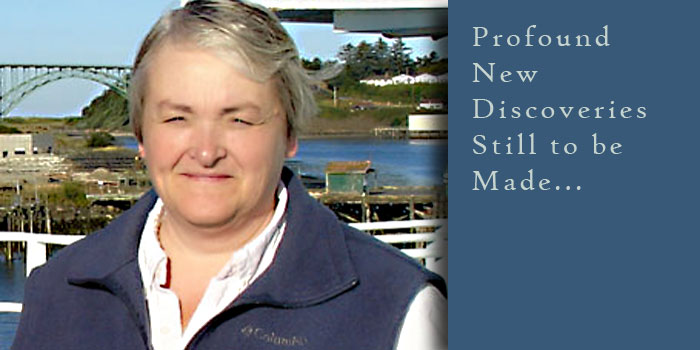
I think some of the advice I would give students that wanted to look at the ocean is, one; to realize it takes several years to get yourself in the right place
Closing Comments
I think some of the advice I would give students that wanted to look at the ocean is, one; to realize it takes several years to get your place... yourself in the right place. To have enough knowledge, enough vocabulary, to really pick some good science questions. So just some patience and hard work is one of them. But then I think the other thing is to recognize that discoveries are still... There's abundant chances and opportunities for new discoveries to be made.
It's always hard to tell what opportunities come along. In my case I don't think I'll ever find a discovery like we did for Lost City and it just happened to be that I was in the right place at the right time. And so I think just some persistence in recognizing that the Ocean is a very large place and we don't know much about it yet. So even for the next several decades there's going to be profound new discoveries to be made there.
I think if you... if you work on good science problems to really get to... I think the major discoveries now are going to be at the interfaces of the different kinds of sciences and so the more you can learn about how our planet works at a broad scale I think will serve you well to really home in and be at the right place to make discoveries.
Return to profile